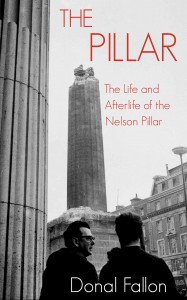THE PILLAR: THE LIFE AND AFTERLIFE OF THE NELSON PILLAR
Published in Book Reviews, Featured-Book-Review, Issue 1 (January/February 2015), Reviews, Volume 23 DONAL FALLON
DONAL FALLON
New Island
€14.99
ISBN 9781848403260
When the Berlin Wall was attacked and conquered by an agitated mob in 1989, it was followed quickly by the tearing down of statues of the old regimes in Eastern Europe. More recently, in 2003 the world witnessed the attack on the statue of Saddam Hussein in Baghdad; although very much staged for the media, there was a certain cathartic flavour to the event. Little was done in Ireland in 1922—there was no outpouring of anger and grief against British symbols. In reality, the only thing the Free State government did as regards ‘change’ was to purchase a couple of hundred tons of green paint and veneer over the red postboxes, and announce with a certain satisfied pride that ‘now we have a country’. The most obvious example of the ‘renationalisation’ of Ireland was the blowing up of Nelson’s Pillar in 1966. One could argue that the most notable aspect of the Pillar is that it was blown up but Donal Fallon does not concentrate specifically on this aspect of the monument; rather he has written an entire history of Nelson’s Pillar.
Considering that no one has ever been charged for destroying the Pillar, writing about it could be fraught with difficulty, but Fallon does not skirt around the issue of who planted the device. He explains that it was not the IRA per se who were responsible but rather an offshoot. The bombing of Nelson’s Pillar is now known to have been the action of one-time members of the ‘Christle Group’, a network of republican activists built around the charismatic Joe Christle. One republican who was close to Christle was Liam Sutcliffe, who, Fallon explains, ‘is the only member of the group to have publicly spoken of the attack on the Nelson Pillar’. In 2000 Sutcliffe spoke candidly about his role in the destruction of the monument and was subsequently questioned by the Gardaí, which he amusingly described as being similar to ‘someone being arrested in the 1950s for taking over the GPO in 1916’. How many times have we heard the tale of how every window within a mile of the Pillar was blown in when the Army Corps of Engineers demolished the remaining stump? Fallon quotes from Tony Killian and demonstrates that this may be the stuff of urban legend—at c. £4,000 ‘the damage claims from the second explosion were less than a quarter of those from the initial blast’.
Fallon does not concentrate all his efforts on Nelson. We are treated to a complete list of the various monuments and symbols that suffered attack or were removed officially over the twentieth century. For instance, Queen Victoria—the ‘Famine Queen’, as Maude Gonne christened her—was squatting on Leinster Lawn for a number of years, keeping her eye on the Irish in the Dáil. After much discussion during the reign of Éamon de Valera as to what to do with the statue, she was removed in 1948 and stored in a museum overspill in the old reformatory in Daingean, Co. Offaly. In 1986 the statue was gifted to the people of Sydney in preparation for the city’s bicentennial year in 1988.
The book is written in Fallon’s easy-going and accessible style and contains plenty of little nuggets and anecdotes. The operation to blow up the Pillar was code-named ‘Humpty Dumpty’, which brings to mind Joyce’s prescient ‘Ballad of Persse O’Reilly’ in Finnegan’s Wake: ‘Have you heard of one Humpty Dumpty, How he fell with a roll and a rumble’, etc. The account of the stealing of Nelson’s head and its subsequent display in Benny Gray’s antique shop in London is particularly interesting.
As regards the decision to blow up the Pillar, it seems that, like all good ideas, it was first discussed by Sutcliffe ‘. . . in a bar on the Crumlin Road in Belfast, out of a belief that the jubilee of the Easter Rising would be better marked by removing the Admiral than “functions and dinners” organized by the State’. The Spire of Light, designed by a firm of architects in London, was completed in 2003, and when interviewed by the Irish Times Liam Sutcliffe said that it was ‘a much better thing to have on the main street than an old foreign admiral with a broken arm and a missing leg’.
The Pillar is well illustrated with a number of images that are rarely seen, including a select few by Pól Ó Duibhir, who was lucky enough to have a camera and be in the right place on more than one occasion. Not only did he capture some great shots of the destroyed Pillar but he also managed to stumble upon a carload of students smuggling Nelson’s head at Killiney. Although the book is fairly priced at ?14.99, I would happily have paid a bit extra for better-quality glossy paper to do justice to the wonderful photographs.
Reviewed by
Lorcan Collins
Lorcan Collins is co-editor of O’Brien Press’s ‘16 Lives’ series and runs the 1916 Rebellion Walking Tour.
















